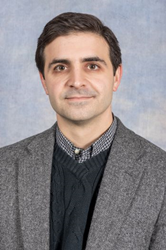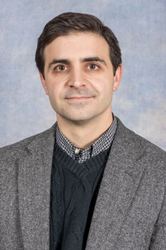[ad_1]

Dr. Lombardi
“I think the grant’s success demonstrates the Mount’s commitment to undergraduate research.” – Assistant Professor of Chemistry Patrick Lombardi, Ph.D.
EMMITSBURG, Md. (PRWEB)
September 30, 2020
Mount St. Mary’s University received a National Institutes of Health (NIH) Academic Research Enhancement Award, also known as an AREA Grant or an R15, for $433,784 which provides increased summer research opportunities for students, travel to scientific conferences to present their work and learn from others, and access to experimental approaches with state-of-the art laboratory equipment.
“I think the grant’s success demonstrates the Mount’s commitment to undergraduate research,” said Assistant Professor of Chemistry Patrick Lombardi, Ph.D., who serves as the principal investigator. Lombardi’s successful grant proposal, to better understand how the cell’s DNA repair machinery is recruited to sites of DNA damage, included important preliminary data collected from a research group of Mount students.
The Mount’s School of Natural Sciences and Mathematics invested in student success by providing paid research positions for 10 weeks over the summer. As a result of these summer research internships, students’ key findings were included in the NIH grant application.
“Over the last three years, 15 students have worked on this project in our laboratory. Six of these students were Summer Research Internship Award (SRIA) winners,” Lombardi said. “The ability for students to work over the summer, without their usual responsibilities of the academic year, was essential for our group to generate the materials and collect the data necessary for this grant application.”
After receiving good news of the award from Grants Manager Kathy Criasia, Lombardi immediately shared it with his students. “I wanted the students to know they’re making exciting discoveries about an important biological question. I hope they feel a sense of personal accomplishment in the application’s success,” he said. These discoveries can one day lead to effectively diagnosing and responding to diseases that arise from malfunctions in DNA damage repair, Lombardi explained.
Funds from the NIH grant will support six undergraduate researchers working full time in the laboratory for nine-week periods during each of the next three summers and fund equipment use costs at collaborators’ laboratories at Johns Hopkins University. Funds will also pay for reagents necessary to perform the proposed experiments and purchase additional cell growth and protein purification equipment to increase research capacity. The grant will also allow more students to participate in the project and to travel to scientific conferences to present their research. The proposed experiments will be conducted over a three-year funding period from September 15, 2020, to August 31, 2023.
“In my three years at the Mount, I’ve noticed the tremendous positive effect that working in the laboratory over the summer has on our undergraduate researchers,” he said. “By immersing themselves in the laboratory, students are able to master the experimental techniques that are necessary for their projects and become independent researchers. Given their proficiency in the laboratory, these students are then able to continue with their research during the academic year and can accumulate a significant body of work during their undergraduate careers. The laboratory skills and records of accomplishment garnered by these students make them strong candidates for external fellowships that enhance their scientific training even further.”
Lombardi, who received his Bachelor of Science degree in chemistry from Yale University and earned his doctoral degree in chemistry from the University of Pennsylvania, is an ambassador for student research.
In 2012, he was a postdoctoral fellow researching ubiquitin in the laboratory of prominent researcher Cynthia Wolberger at Johns Hopkins University. Lombardi was part of a cohort who showed that in response to a certain type of unwanted DNA modification known as alkylation damage, chains of the protein ubiquitin are assembled in proximity to damage sites to recruit the cell’s DNA repair machinery.
The findings of this discovery were published in 2017 in Nature, a world-renowned scientific journal featuring peer-reviewed research in science, technology and the natural sciences. He is also the recipient of a National Cancer Center Postdoctoral Fellowship Award and an American Cancer Society Postdoctoral Fellowship Award.
“I’m very grateful to the 20 students who have been part of our research group over these last three years,” Lombardi added. “In August 2017, our laboratory, COAD 123, was an empty room with a wooden crate of unboxed research equipment. Through their hard work and determination, the students transformed that empty space into a functioning biochemistry laboratory. Eleven of the 20 students are graduating seniors this year, and it’s hard for me to imagine the Mount without them. While it will be difficult to see these lab members leave the group, I’m very excited for all the wonderful accomplishments that lie ahead in their futures.”
Additional data has been collected since the grant application submission in February; Lombardi is working with collaborators to prepare a manuscript for publication that will include several Mount undergraduates as coauthors.
About Mount St. Mary’s University
Mount St. Mary’s University is a private, liberal arts, Catholic university in the Catoctin Mountains near historic Emmitsburg, Maryland, with a satellite campus in Frederick, Maryland’s second largest city. The university offers more than 80 majors, minors, concentrations and special programs for traditional undergraduate students, and more than 20 adult undergraduate and graduate level programs as well as 24 NCAA Division I athletic programs. The Mount includes Mount St. Mary’s Seminary, the second oldest in the United States, and the National Shrine Grotto of Our Lady of Lourdes, an idyllic shrine for spiritual reflection located on the hill above the university.
Share article on social media or email:
[ad_2]

